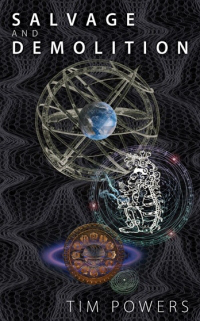Richard Blanzac works in salvage and demolition—or at least, that’s what he tells Sophia Greenwald when he travels back in time to destroy her life’s work. Mere hours before that, he had read Greenwald’s manuscripts alongside Ginsburg and Kerouac, but the beats are the least of his worries when he arrives in 1957; Blanzac must stop a mythic organization from using Greenwald’s work to open up the proverbial wormhole that will suck all of mankind into non-existence. That’s right—not destruction or even death, but to the state of never having existed in the first place.
Tim Powers’ upcoming novella, Salvage and Demolition has all of the elements of an entertaining, rainy-afternoon read: time travel, evil religious sects, action, romance, and enough whiskey and cigarettes to give Mad Men a run for its money. It lacks a heap of essential development, though, so if you’re looking for plot and character growth, you’d best go elsewhere for your two hours of reading. For hijinks and entertainment, however, do read on.
[Read more]
In the year 2012, a man named Blanzac works with rare books. Aside from having the opportunity to touch first editions of Hemingway whenever he wants, his life is, as it goes, as ordinary as they come. When he receives a box of books from Sophia Greenwald’s niece, he is pleased to find an autographed copy of Howl hidden beneath the old cigarette ash and other trash (a TV guide, a tongue-in-cheek science fiction novel). He is called, however, to a nursing home to speak to Sophia Greenwald’s snarky, elderly literary executor. The woman tells him to destroy the manuscripts. And so the fun begins.
Blanzac is in the process of deciding how best to copy the manuscripts before destroying them when he finds his office disappearing around him. He goes through the more obvious options—alcohol poisoning, hallucination—but only gradually comes to the realization that he has skipped through time when a beautiful young woman takes his arm and aids in convincing him. Sophia Greenwald, young and every bit as snarky as her “literary executor” tells Blanzac that she had met him a mere few hours before and that he has promised to help her escape from a tricky situation.
Sophia’s tricky situation is of Indiana Jones proportions—and just like Indy, who makes archaeology seem like a far more exciting and life-threatening profession than it actually is, Sophia turns the art of translation on its head. A mysterious group has hired her on to translate an ancient Sumerian text, one, which, upon every other attempt at translation throughout history, the translator has gone mad or killed themselves. She is well aware, though, of its purpose—to create a portal in space, of sorts, to God (or creation)’s antitheses. This anti-God is the “reductio ad nihilum,” the opposite in every way of God, to the point of non-existence. If enough people witness this text—this “apologia pro deletu meo”—they will find the hole in space where the anti-God is, and they will achieve non-existence, or, if you’re an evil mastermind, a weird kind of immortality. After all, you can’t die if you never existed in the first place.
Sophia, needless to say, has gotten cold feet. Using 20th century mass media to suck helpless bystanders into nothingness is not something she wants on her resume. She drinks in order to forget what she’s read, and in order to cut the subconscious connections she’s forged with her employers, while Blanzac, still coming to terms with existing during Eisenhower’s presidency, drinks with her. They forge a connection through mutual fear, drunkenness, and appreciation of poetry, and they fall in love within the course of their 24-hour adventure.
Without spoiling what happens, the ending is relatively predictable, if bittersweet. The time travel remains unexplained (though Blanzac wouldn’t have the vocabulary to speak of such things, so perhaps it’s more realistic that way), and inspires a hurried, insipid, and entirely useless plot revelation at the end of the novel. Also: yes, Sophia’s literary executor is Sophia herself, but no, nothing weird happens between Blanzac and her elderly self.
I was excited by the prospect of Salvage and Demolition if only because of its packaging. The novella, like flash fiction and prose poetry, is one of the more exciting innovations in form to come about in the past century. It takes what is succinct and poignant of a short story, adds the detail and continuity of a novel, and ultimately presents a new creature entirely—one more like a film, more like a full-length album than its older counterparts.
I wanted Salvage and Demolition to flourish with all that its form had to offer, but it didn’t. It felt far more like a novel stripped of detail or a short story that bit off more than it could chew. It was a nice, short romp through another time and place—I would liken it to a film, for sure— but it lacked detail, particularly of the magical nature of the Sumerian translation and of the time travel. I understand, of course, that the novella was meant to be more about the characters than their fantastical situation, but if that’s the case, why did it feel as though Blanzac hadn’t changed by the story’s end? Why were love and death the only game-changers of the entire text?
Salvage and Demolition has the workings of something exceedingly fun, but it lacks the follow-through. The gratuitous graphic design, not up to J.K. Potter or Subterranean Press’ usual, more nuanced standards, distract from the already hurried nature of the story. It’s worth a look, though, or at least the couple of hours it takes to dip your toes in. The novella will be released on January 31st of this year, and is available for preorder on Subterranean’s website.
Emily Nordling likes good books, bad tv, and superior tea.










